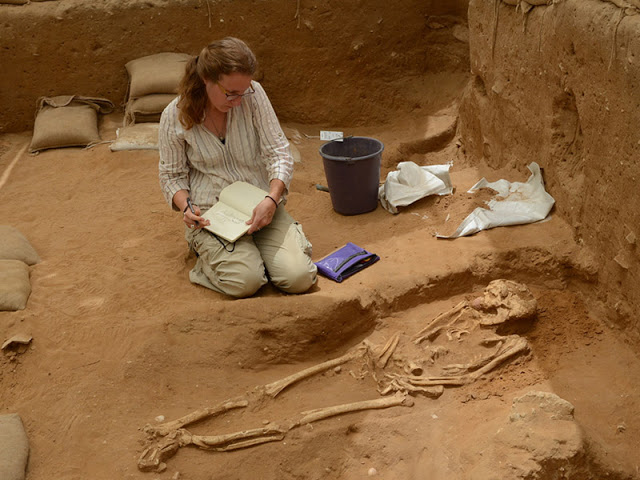One of the most enduring biblical mysteries is that of the origins of the ancient tribe called the Philistines. Little was known about the Philistines for years, but now, a recent excavation in Ashkelon, an Israeli port city, might have uncovered some answers.
The Philistines are familiar to people mostly because of the Bible’s Old Testament. These accounts were written by the Philistines’ neighbors and bitter arch enemies, the Israelite’s. In the book of Samuel, for example, Philistine fighters captured the Ark of the Covenant, where the Israelite’s stored the tablets that the Ten Commandments were written on, and the duel between the giant Goliath and David.
Although the specifics of their lifestyle are relatively unknown, researchers do know that the Philistines flourished in Mediterranean area beginning in the 12th century BC. The current excavation is located in the city of Ashkelon, where archaeologists have uncovered a cemetery that contains the remains of about 150 Philistines in numerous burial chambers—some of which hold surprisingly sophisticated items. It’s the first Philistine cemetery ever found. It is the crowning achievement after three decades of work.
The reason the items are surprising is due to the way modern English uses the term “philistine.” Today, we use the word as a derogatory label, and it is usually directed at a person who is considered uncultured and unfamiliar with arts.
The discovery at Ashkelon means that we might have to revise this opinion, said archaeologist Lawrence Stager, who has led the excavation since 1985.
“The Philistines have had some bad press, and this will dispel a lot of myths,” Stager said. His team had to dig down ten feet down in order to uncover the cemetery. Interestingly, the cemetery was used centuries later as a Roman vineyard.
“After decades of studying what Philistines left behind, we have finally come face to face with the people themselves,” added Daniel M. Master, who is a professor of archaeology at Wheaton College and is one of the leaders of the excavation. “With this discovery we are close to unlocking the secrets of their origins.”
Called the sea people by the Phoenicians, the Philistines appear to have been strangers in the Semitic region, according to researchers. The red-and-black pottery found in their cities indicate that they might have come from the Mycenaean civilization of the Aegean Sea.
On top of that, they were traders and seafarers, who spoke an Indo-European language. Unlike their neighbors, the Philistines did not practice circumcisions and ate pork—as proven by the bones found in the ruins of their cities, Gaza, Gath, Ashdod, and Ekron.
“The cosmopolitan life here is so much more elegant and worldly and connected with other parts of the eastern Mediterranean,” Stager said, He continued, adding that this a direct contrast to the modest village lifestyle of the Israelites.
If the artifacts do not quite connect the Philistines with their ancestors, researchers have another lead: DNA. In other Philistine sites, there have been human remains, but they have been too small to be suitable for DNA testing.
You can visit the Leon Levy Expedition to Ashkelon.
In this cemetery, however, more substantial samples have been acquired. This means that researchers can use DNA to trace the Philistines’ lineage.
Sherry Fox, anthropologist, and pathologist from the USA, showed reporters the skull of a skull of a 35-year-old Philistine woman that was found. Archaeologists have also found complete skeletons that had been buried with perfume bottles near the faces, as well as adorned with necklaces, bracelets, earrings, and toe rings. Others had been buried with their weapons.
There were even several cremation burials, which is extraordinary considering that cremations were rare and expensive during that time. The remains were buried in small jugs. There were larger jugs that hold the, non-cremated, bones of infants.
Fox explained the other revelations they have had during the dig. According to her, although their life was full of luxurious goods, it was not necessarily an easy life. “In their teeth, we can see that they did not have an easy life,” she said. “We see these lines that indicate a growth interruption as the teeth are forming.
There were problems in childhood with either fever or malnutrition.” She held up a skull as she said, “We also see from their bones that they were hard workers, they practiced inbreeding, and they used their teeth as tools, probably in the weaving industry.” She added that there had been no evidence of any Goliath-sized giants yet found.
As the artifacts and remains have been discovered, they have been moved to a tented compound for further study. Some fragments have been reconstructed. Moreover, the team meticulously mapped the position of every bone found—they are doing this in order to produce a digital 3D model of the site.
The discovery of the cemetery was kept quiet for three years, until after they finished excavating. The team was worried that the dig would attract ultra-Orthodox Jewish protestors. One archaeologist comments, “We had to bite our tongues for a long time.”
